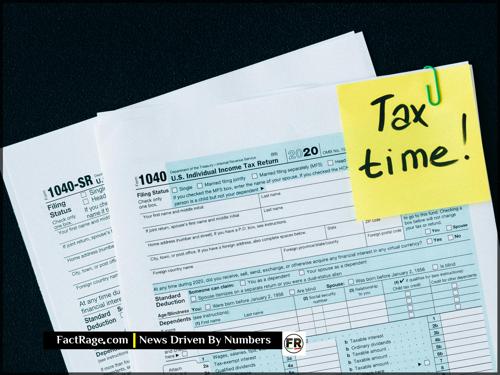FACTRAGE – As the midpoint of 2025 passes, financial experts are advising taxpayers to conduct a mid-year financial review to optimize their tax position and avoid potential penalties before year-end.
- Withholding Adjustments – Major life events like marriage, a new job, or a significant salary change often require adjusting your Form W-4 to ensure the correct amount of tax is withheld from your paycheck, preventing a large bill or refund.
- Retirement Contributions – Maximizing contributions to tax-advantaged retirement accounts like a 401(k) or traditional IRA by year-end can directly lower your 2025 taxable income. The 2025 401(k) limit is $23,000.
- Capital Gains Planning – Reviewing investment portfolios now allows for strategic decisions, such as tax-loss harvesting, where investment losses are used to offset gains and potentially reduce your overall tax liability.
Waiting until next April to address your tax situation can be a costly mistake. A proactive check-up now provides the opportunity to make strategic adjustments with months left in the year to see the benefits.
Your Tax Bill Is a Story Written in Monthly Increments
![]() Many view their annual tax filing as a single, stressful event. But from an analytical perspective, your final tax liability is simply the sum of financial decisions made over twelve months. A mid-year review isn’t just about avoiding a surprise bill; it’s an exercise in strategic data management, allowing you to adjust the inputs that will define your financial outcome next April.
Many view their annual tax filing as a single, stressful event. But from an analytical perspective, your final tax liability is simply the sum of financial decisions made over twelve months. A mid-year review isn’t just about avoiding a surprise bill; it’s an exercise in strategic data management, allowing you to adjust the inputs that will define your financial outcome next April.
Read On…
Our guide breaks down the three critical areas—withholding, retirement, and investments—that you can optimize right now for a more favorable tax position.
Why Your Paycheck Withholding Needs a Second Look

For most salaried employees, federal income tax is a set-it-and-forget-it deduction. However, life changes can quickly make your initial withholdings inaccurate. A mid-year check of your Form W-4, which dictates how much tax your employer withholds, is a critical first step. What kind of changes warrant a review?
Significant life events are the primary trigger. This includes getting married or divorced, having a child, or a spouse changing jobs. A substantial pay increase or taking on a second job with its own income stream also requires an adjustment. Using the IRS’s online Tax Withholding Estimator can provide a precise recommendation. Failing to adjust can lead to under-withholding, resulting in a surprise tax bill and potential penalties. Conversely, over-withholding means you are essentially giving the government an interest-free loan that you won’t get back until your refund next year.
How Maximizing Retirement Accounts Now Reduces Your Tax Bill
One of the most effective ways to lower your taxable income is by contributing to tax-deferred retirement accounts. A mid-year review gives you time to calculate if you are on track to maximize these benefits. For 2025, the employee contribution limit for 401(k), 403(b), and most 457 plans is $23,000. Individuals aged 50 and over can contribute an additional $7,500 as a “catch-up” contribution.
Contributions to a traditional 401(k) or a traditional IRA are made with pre-tax dollars, which directly reduces your adjusted gross income (AGI). For example, a person earning $80,000 who contributes $10,000 to a 401(k) will only be taxed on $70,000 of income. Similarly, Health Savings Accounts (HSAs) offer a triple tax advantage—tax-deductible contributions, tax-free growth, and tax-free withdrawals for qualified medical expenses—and are another powerful tool for those with high-deductible health plans.
What to Do With Your Investments and “Other” Income
A mid-year review is also the ideal time to analyze your investment portfolio and any non-W-2 income. For investors, this is an opportunity for tax-loss harvesting. This strategy involves selling investments at a loss to offset capital gains realized from selling profitable assets. Taxpayers can use capital losses to offset capital gains without limit. If losses exceed gains, up to $3,000 per year can be used to offset ordinary income.
For individuals with income from freelancing, a side business, or the gig economy, taxes are not automatically withheld. These taxpayers are generally required to pay estimated taxes in quarterly installments. A mid-year check ensures these payments are sufficient to cover the tax liability from this extra income. Looking ahead, it is also important to note that many provisions of the Tax Cuts and Jobs Act of 2017 are set to expire after December 31, 2025. This could lead to significant changes in tax rates and deductions for the 2026 tax year, making proactive planning in 2025 all the more crucial.
The Bottom Line: A Forward-Looking Approach to Your Finances
![]() Ultimately, a mid-year tax review is less about compliance and more about strategic financial management. The numbers show that proactive adjustments to withholding, retirement savings, and investment strategies can yield significant returns in tax efficiency. As the current tax landscape prepares for potential shifts with expiring legislation after 2025, taking deliberate, data-informed action now is the most logical step to safeguard your financial position for the years ahead.
Ultimately, a mid-year tax review is less about compliance and more about strategic financial management. The numbers show that proactive adjustments to withholding, retirement savings, and investment strategies can yield significant returns in tax efficiency. As the current tax landscape prepares for potential shifts with expiring legislation after 2025, taking deliberate, data-informed action now is the most logical step to safeguard your financial position for the years ahead.












